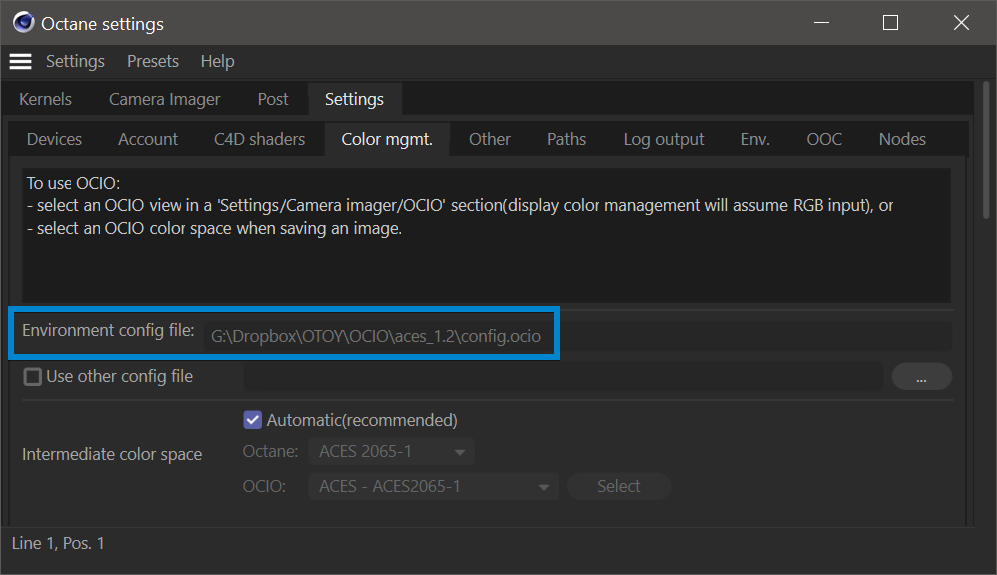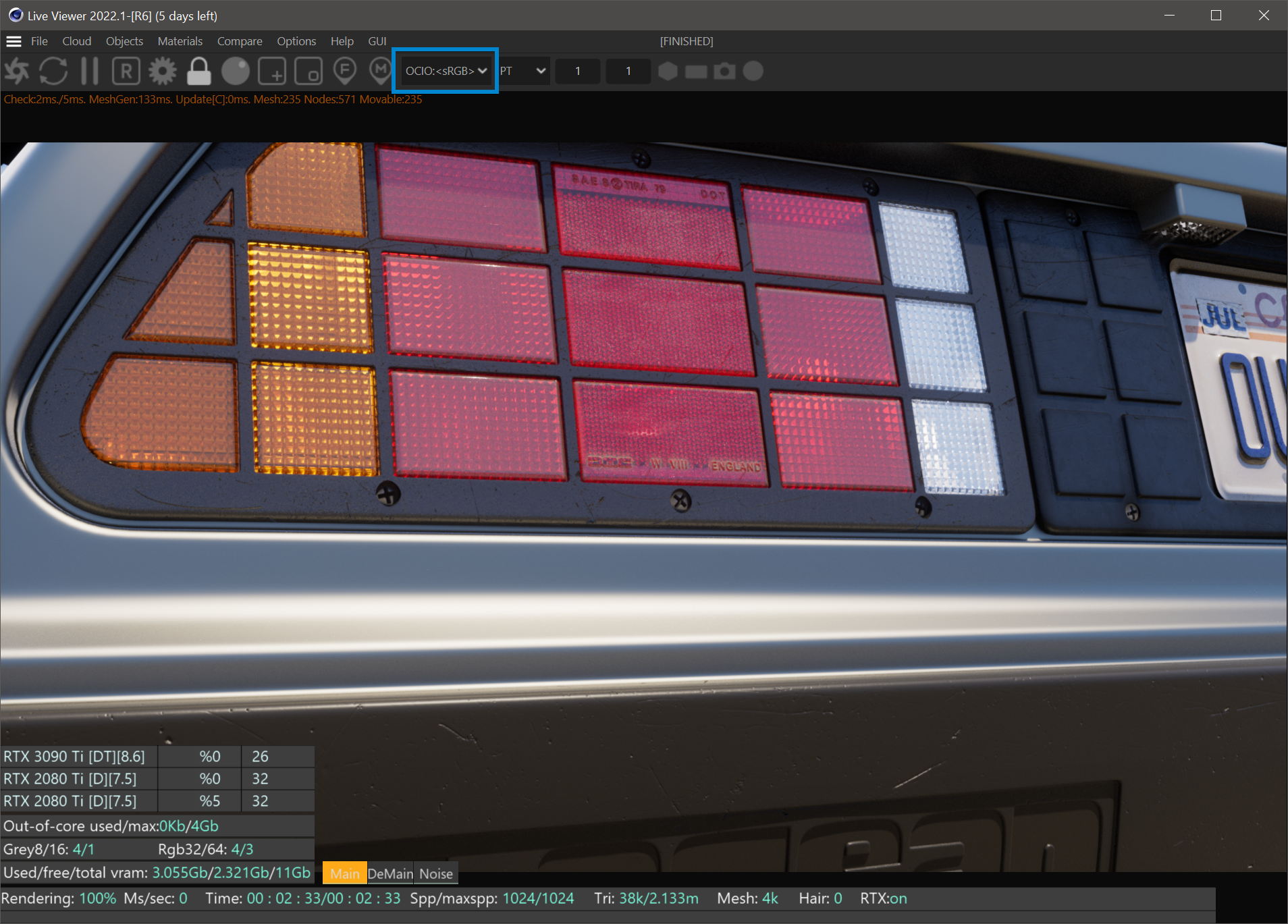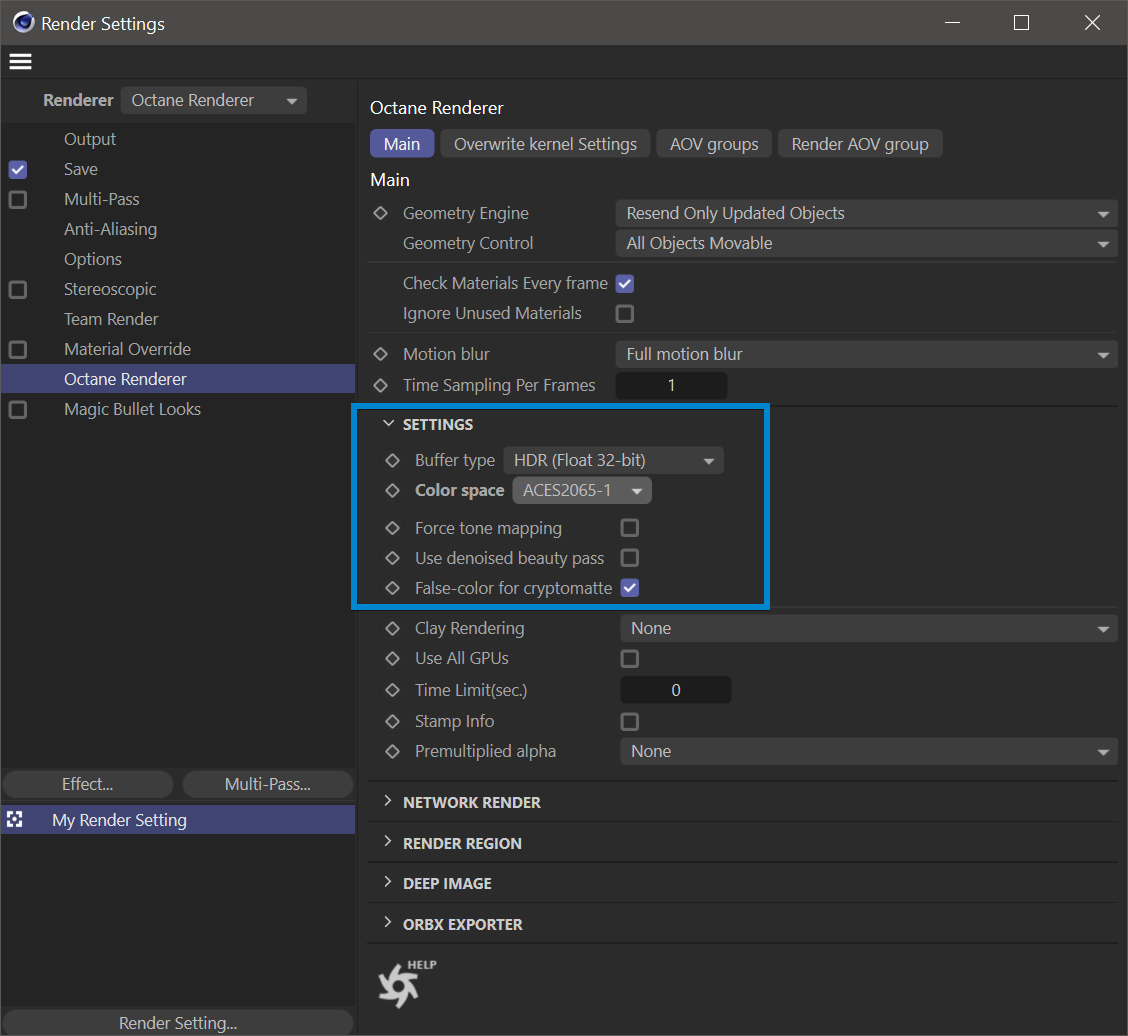Moderate: ACES & OCIO Quick Start
This section will quickly get you up to speed to use ACES/OCIO in OctaneRender®.
|
ACES/OCIO Quick Start |
|
|
Go to this link: https://github.com/colour-science/OpenColorIO-Configs/tree/feature/aces-1.2-config |
|
Live Viewer > Settings > Color Management tab |
|
Live Viewer > Camera Imager > OCIO tab |
|
Render Settings > Octane Renderer panel > Main tab |
|
Render Settings > Octane Renderer panel > Render AOV Group tab |
The table above contains the information required to get immediately up to speed on the ACES/OCIO implementation in Octane.
Required File Package: Config.OCIO
Config.ocio is a file package which contains references to a myriad of color lookup tables (LUTs), python configuration code, color spaces and ICC profiles included with a given ACES/OCIO installation. This file can be set up as an environmental variable so that any application on a given computer can access it, or it can be loaded individually into Octane.
The link in the table references the Academy of Motion Picture Arts & Sciences implementation of OCIO, but there are others as well. As noted above, a version of OCIO can be made available to all applications by use of an Environmental Variable, but it is also possible to choose different OCIO configurations, even if one is specified at the system level.
To download the OCIO file package, use the link in the table above. You will need the contents of the entire archive for the config.ocio file to work properly and offer the various options.
|
If you are familiar with creating Environmental Variables, you can set one up for your config.ocio file. This will enable ACES for ALL applications on your system that are ACES and OCIO aware. If you do go this route, the next time you launch Octane, the config file will be listed in the Environment config file slot in the Color Management tab of the Octane Settings window in Live Viewer. You also have the option of using a separate config file for Octane, and that is what the Use Other config file slot is meant for. |
Set Up Color Management: Live Viewer > Settings > Color Management tab
The config.ocio file is needed before any other ACES/OCIO operations can be undertaken. As noted, the location of this file can be set as an Environmental Variable. This step is not necessary, and the config.ocio file can be directly loaded into Octane in the Color Management tab. Once the config.ocio file is loaded or referenced, all the ACES/OCIO functions in Octane will be enabled.
If you choose to use a different config file, you can do so by enabling the Use Other Config File option. You can then choose a different location that contains a valid config.ocio installation to use instead. Should you choose to do so, the Environment Config file will not change, and can be re-enabled by disabling the Use Other Config file toggle.
|
|
live viewer — ocio configuration
|
Intermediate Color Space
In the Color Management tab, the Automatic toggle will set up the Octane and OCIO intermediate color spaces for you. The Automatic toggle is enabled by default, which guarantees that the Octane and OCIO color spaces are in sync (as they must be for ACES/OCIO to work properly). To choose alternative intermediate color management, disable the Automatic switch, and additional choices will then become available. If you change these two settings, you must ensure they match each other. Some config.ocio files have a broader selection than others. The config.ocio file referenced in this topic offers only the ACES 2065-1 choice for Octane; therefore, the only option to use for OCIO is also ACES 2065-1.
View and Look Menus
All the View and Look menus conform to the category assignments contained within the config.ocio file package. These options will differ depending upon the config.ocio file version you have installed (there are several). The current version is ACES 1.2, as of this writing. You may not see any Looks available in the Looks menu as the ACES 1.2 config file does not have any Looks defined. Other config.ocio versions do have looks defined and these looks will appear in the Looks menu.
Look Dev: Live Viewer > Camera Imager tab > OCIO
Live Viewer is used for look and material development. In the Camera Imager tab of the Live View settings, you are setting up the View Display Transform for the Live Viewer only. There is a duplicate of these settings in the Octane Renderer > Main tab for final renders. The Camera Imager tab sets up Live Viewer for look development by the ACES: sRGB view option. This option properly converts an ACES 2065-1 or ACEScg image for viewing on an sRGB monitor.
|
|
camera imager ocio tab
|
The Look menu will have options only if the config.ocio file has looks defined. The ACES 1.2 config.ocio package does not contain any defined looks. If that is the config installed, this menu will be empty.
Using Live Viewer for Look Dev
As ACES/OCIO is now installed, Live Viewer can be used for accurate look and material development, once the Colorspace Switcher is set to OCIO. OCIO is the only option in the switcher which will insure accurate and consistent look development with ACES/OCIO. The other options serve different purposes, such as LDR sRGB for viewing Cryptomatte and Z depth output. See Exploring the Live Viewer for more information.
|
|
live viewer ocio
|
Preparing Final Renders: Render Settings > Octane Renderer panel > Main tab
For Final render output, again in the Main tab of the Octane Renderer settings, make sure the Buffer type is set to HDR (Float 32-bit) and the Color space is set to either ACES2065-1 or ACEScg. ACES 2065-1 is the full range color space, appropriate for Octane as it is a spectral renderer, whereas ACEScg is intended for RGB render engines, and is a reduced color space. Either will work, though ACES2065-1 has the most greatest color range — most compositing applications can handle the ACES 2065-1 spec.
|
|
octane Render Settings — Main Tab
|
Image Texture Inputs
Image textures, via the Image Texture node, can use any of the color spaces built into Octane or any available OCIO color space (contained within the config.ocio package installed). Any textures coming through an ACES pipeline can use ACES 2065-1 or ACEScg, or apply any ACES Image Display Transform (IDT) through OCIO. Octane can be used in an end-to-end ACES workflow with these improvements. This removes the restriction in the Octane 2020 series from using ACES IDTs in image textures.
Proofing ACES Output
|
NOTE: The Cinema 4D Picture Viewer cannot show an accurate OCIO or ACES presentation without the proper settings, as desribed in our Octane ACES/OCIO User Guide for Cinema 4D, or in this section. Octane will render and save files correctly, but the image seen in the Picture Viewer will not match the Live Viewer image without these settings being applied. Applications such as Affinity Photo and Adobe After Effects v.23.1 (no earlier) can be used for accurate proofing . |
Adobe Photoshop cannot show the proper ACES/OCIO renders without a third-party plugin, link supplied in the table, below. Affinity Photo can be used as a proof system as it is ACES/OCIO compliant. Adobe After Effects v23.1 can display ACES/OCIO rendered files directly, though the settings will need to be configured. Likewise, Nuke and Fusion will need proper settings applied for ACES/OCIO display. Please refer to the documentation for those products for workflow information.
|
Useful ACES/OCIO Image Viewing Information |
|
|
Ensure the gamma and type values are correctly set in the Image Texture, otherwise the default values will be used. |
|
|
|
|
|
Render Settings > Save panel |
|
Edit > Project Settings > Project tab > Color Management |



